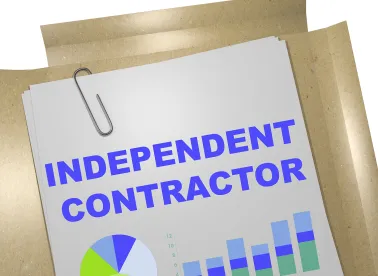The U.S. Department of Labor (“DOL”) published a final rule (the “Final Rule”) in January of this year, which took effect March 11, 2024 and changed how the DOL analyzes whether a worker is properly classified as an employee or independent contractor under the Fair Labor Standards Act (“FLSA”).
Employers who wrongfully classify individuals as independent contractors (who should properly be classified as employees) can be held liable under the FLSA for failure to pay minimum wages and overtime pay for up to the preceding three years, plus liquidated damages in an equal amount and attorneys’ fees. Both employers and executives can face civil and criminal penalties for violations of FLSA laws, which is an area of intense focus by the DOL, who has recently hired many new investigators to enforce FLSA compliance. So what should companies know when determining whether to classify a worker as an employee or contractor in light of the Final Rule? Although recently enacted, this “new” rule is rather a return to the DOL’s prior analysis and comports with longstanding judicial interpretations of the FLSA.
Background
The FLSA itself does not indicate how to determine whether to classify a worker as either a contractor or employee. Therefore, prior to the DOL issuing any formal guidance, courts across the country developed some version of the “economic reality test” focusing on the relationship between the employer and the individual, though there was variation as to the number of factors considered or how the factors are framed. These varying tests led to disparate results under the same or similar circumstances, causing great uncertainty for employers with workers in multiple jurisdictions.
In an effort to promote consistency for entities covered by the FLSA, the Trump-era DOL issued the Independent Contractor Status Under the Fair Labor Standards Act rule (the “Prior Rule”) on January 7, 2021. The Prior Rule encompassed a five-factor economic realities test, but identified two “core” factors: “the nature and degree of the individual’s control over the work” and “the individual’s opportunity for profit or loss.” If these factors pointed to the same conclusion, there was no need to explore further, the DOL said. Otherwise, three “non-core” factors to be considered were (i) the amount of skill required for the position, (ii) the permanence of the working relationship, and (iii) how integrated the worker’s role is to the organization’s overall operation.
The effective date of the Prior Rule was slated for March 8, 2021. After the Biden Administration took office, however, the DOL published a new independent contractor rule on March 4, 2021, delaying the effective date of the Trump-era rule after only a 19-day comment period (the “Delay Rule”). Then, on May 6, 2021, the DOL published a rule attempting to withdraw the Prior Rule altogether, rather than proposing a new or modified version (the “Withdrawal Rule”). In March 2022, a Texas federal court reinstated the Prior Rule, noting the DOL failed to provide a sufficient comment period and impermissibly failed to consider alternatives when it withdrew it. Therefore, U.S. District Judge Marcia A. Crone retroactively enacted the Prior Rule to the date the Trump Administration originally scheduled it, i.e., March 8, 2021. That case was held in abeyance pending the DOL formulating a new rule.
The Final Rule
After considering feedback provided by stakeholders at forums in the summer of 2022 and during the comment period after the Final Rule’s proposal announcement in October 2022, the Final Rule officially rescinded and replaced the Prior Rule. Instead of using the “core factors” set forth in the Prior Rule, the Final Rule returns to a totality-of-the-circumstances analysis of the economic reality test in which the factors do not have a predetermined weight and are considered in view of the whole activity.
Under the Final Rule, there are six factors that guide the DOL’s analysis of a worker’s relationship with an employer:
- whether the worker exercises managerial skill that affects the worker’s opportunity for profit or loss;
- whether any investments by a worker are capital or entrepreneurial in nature;
- the permanency of the work relationship;
- the nature and degree of the employer’s control over key aspects of the performance of the individual’s work;
- the extent to which the work performed is an integral part of the employer’s business; and
- whether the worker uses specialized skills and business-like initiative to perform the work.
Because the FLSA’s text does not define the analysis to be used in determining a worker’s proper classification under that statute, courts are apt to apply Chevron deference—which requires a court to abide by an agency’s interpretation of an ambiguous statute, so long as the agency’s interpretation is reasonable—to the DOL’s Final Rule.
Importantly, the Final Rule is currently facing its own legal and Congressional challenges, including the abeyant case pending before federal District Judge Crone in the Eastern District of Texas (which vacated the Biden-era Delay Rule and Withdrawal Rule). In that case, the plaintiffs filed an amended complaint on March 5, 2024 tailored to the Final Rule and in which they argue the Final Rule suffers from the same defects as the Delay and Withdrawal Rules. There are additional challenges to the Final Rule currently pending before federal courts in Tennessee, Louisiana, and Georgia.
Republican Senators Bill Cassidy of Louisiana and Kevin Kiley of California have also introduced a Congressional Review Act (“CRA”) disapproval resolution which, if enacted, would eliminate the Final Rule and reinstate the Prior Rule. The CRA, however, is unlikely to take effect given that President Biden could, and is expected to, veto it in the unlikely event it passes in the Democratic-controlled Senate.
Impact to Employers
Under the Final Rule, economic dependence is the ultimate inquiry, meaning that a worker is an independent contractor as opposed to an employee under the FLSA if the worker is, as a matter of economic reality, in business for themself.
One practical consideration is whether the individual is working as a business—including doing business under an established business entity, such as an LLC or corporation; maintaining business licenses to perform their trade; and engaging in marketing, advertising, or other efforts to expand their business or secure more work.
Although some factors are not susceptible to contracting, e.g., whether the contractor’s work is integral to the putative employer’s business, there are ways to structure the business relationship to make it less likely the worker will be deemed to be an employee, such as:
- allowing the worker to determine or to meaningfully negotiate the charge or fees for the work provided;
- permitting the worker to accept or decline jobs or, where feasible, choose the order and/or time in which the jobs are performed;
- providing an express duration for the relationship, limited either by time or project completion; and
- expressly stating in the contract for services that the relationship is non-exclusive.
The Final Rule does, however, specify that requiring the individual to comply with specific legal obligations, satisfy health and safety standards, carry insurance, meet contractually agreed-upon deadlines or quality control standards, or satisfy other similar terms that are typical of contractual relationships between businesses, would not indicate an employee relationship for purposes of the DOL’s economic reality test.
Of note, the Final Rule only applies to FLSA determinations, meaning employee classification for purposes such as workers’ compensation and unemployment insurance, Form I-9 compliance, and entitlement to benefits under applicable federal and state laws such as the Family and Medical Leave Act (FMLA) and the Uniformed Services Employment and Reemployment Rights Act (USERRA) are unaffected.
Conclusion
With the enactment of the Final Rule, the DOL’s determination of a worker’s status is realigned more closely to longstanding judicial precedent on which employers have previously relied, making consistent enforcement more likely in the years to come.





 />i
/>i
